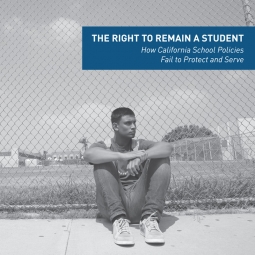

Campus Police Toolkit
Last updated on March 29, 2017
Campus Police Toolkit
The Right to Remain a Student: How California School Policies Fail to Protect and Serve
Police presence on campus has become a troubling reality for many students throughout California. What was once a space for academics and social growth is now an environment where students feel like suspects and criminals. These realities occasionally garner public attention, most often when videos showing police violence against youth on campus shock the nation. Equally shocking—but less reported—are the circumstances surrounding these incidents, the long-term consequences of student interactions with police on campus, and the general lack of district-level policies to govern police conduct on campus.
The ACLU of California's report, The Right to Remain a Student: How California School Policies Fail to Protect and Serve, discusses these effects of increased police presence on campus and reviews school district policies on student discipline and police conduct on campus. Notably, we found that:
- School districts often rely on police officers to handle minor violations, who then frequently mishandle the situation, resulting in harmful consequences for students and families;
- Criminalization has short and long-term damage and funnels students into the school-to-prison pipeline;
- Student-police interactions disproportionately impact low-income students, students of color, and students with disabilities; and
- Many California school districts have conflicting, vague, or absent policies that provide little to no meaningful guidance to school staff on when to call police to campus and how to interact with police.
The report's findings make one thing very clear: districts should not permanently station police on campus. However, as long as police remain on campus, districts must adopt and enforce policies that clearly guide school staff on whether and when they can request police assistance. Similarly, districts policies must establish procedures that protect students' rights during interactions with police.
In addition to the report, the ACLU developed model advocacy resources that help counteract the influence of unconscious bias on staff decisions and eliminate police involvement in school disciplinary matters better left to administrator, counselors, and mental health professionals. The Model Advocacy Resources help community stakeholders identify problematic district policies, develop advocacy strategies, and push their district to adopt and enforce policies that give meaningful protection to students' rights on campus. Keep reading for our Model Advocacy Resources guide.
ACLU Model Advocacy Resources
Advocating for change at the district, school-site, and community level can seem daunting. Getting access to, understanding, accessing, understanding, and challenging the policies that your district uses to govern police conduct on campus can feel overwhelming.
To help community members navigate their district's policies, and understand why, when, and where to use the ACLU's Model Advocacy Resources, we divided the advocacy process into four steps:
To begin, first find the advocacy step that most relates to your current needs.
Some Things to Keep in Mind When Using Our Model Advocacy Resources:
- Annotated Model Advocacy Resources: You will always see two links for each policy resource: one link to a model policy, and a second link to an annotated version of the same model policy. The annotated version describes why the document is important and explains the legal and practical issues in the policy. The annotations can help you identify where your district's policies are insufficient, and give you talking points to support adopting the model policy.
- The Advocacy Steps and Annotations Are Meant to Help — Not Limit — You: The Four-Step Advocacy Process and annotated Model Advocacy Resources are intended to help community members better understand one potential advocacy process, through the School Board. But these documents could be used in many different contexts. Feel free to use them as you see fit.
First, Determine Which Step is Appropriate for You
Do you:
Know there is a police issue on campus, but:
- Do not know if your school has policies about police on campus;
- Know your district has policies about police on campus but do not know how to access the policies; and/or
- Need help understanding your district's policies?
If so, click on "Step One."
Step One: Get the Information
Have your district's policies and:
- Need model policies to help analyze your District's policies;
- Need help identifying which policies are most important for your issues; and/or
- Want to understand why different policies are a better option?
If so, click on "Step Two."
Step Two: Identify the Issues and Your Audience
Know what specific policy changes you want, but need advice for working with the school board or the public?
If so, click on "Step Three."
Step Three: Advocate for Change
Want to follow up on past advocacy to the school board or community by:
- To make sure the school board reviewed your proposal;
- Follow up data about the policy's implementation in your district; and/or
- To gather information about the community's reaction to the new policy?
If so, click on "Step Four."
Step Four: Follow up
Step One: Get the Information
Which ACLU Model Advocacy Resources are most relevant for the issues in your school district depends on whether your district has existing policies about police conduct on-campus. Once you find your district's policies, you can compare them with the ACLU's model school board policies to identify differences and gaps between the two, paying particular attention to the sections we identified as important.
Step Two: Identify the Issues and Your Audience
After locating your district's policies and/or memorandum of understanding (a kind of contract) with the local police department, the next step is to determine whether those policies adequately protect students against needless interactions with police on campus. To measure the strength of your district's policies, compare them with the ACLU's model school board policies.
Looking at your district's policies, you may notice that they are lengthy, not easy to understand, and that it is sometimes difficult to identify and compare what makes them more or less protective of students.
When assigned complicated homework, students often rely on study aides like SparkNotes and CliffsNotes to explain those difficult assignments. Like reading Othello and learning physics and geometry, there can be a learning curve to understanding what a school board policy or memorandum of understanding says. That is where the ACLU of California's Annotated Advocacy Resources come in. Think of the Annotated Resources as a study aide — they make dense legal documents easier to understand by identifying and explaining important provisions.
If Your District Has (or Needs) Better Board Policies:
The Annotated Model board policies translate legalese into plain English to help you understand your district's policies, compare them with the ACLU's model board policies, and identify areas where your district's policies do not protect students enough.
Find your district's board policies that most relate to the issues on your campus. For instance, if police keep searching students on campus, locate your districts "Search and Seizure" board policy. Next, review the ACLU Model Search and Seizure Board Policy and the Annotated Model Search and Seizure Board Policy that goes along with it. Pay special attention to the sections that the Annotated Model Board Policy identifies as important. Do this for all your district's policies that you want to review.
Model School Board Policies:
- Methodology
- Bullying
- Cell Phones
- Complaints
- Data Tracking
- Law Enforcement Contact
- Racial Profiling
- Search and Seizure
- Vandalism
If your school district has its own police department (for example, the Los Angeles Unified School District has its own police department called the Los Angeles School Police Department), then your school district can (and should) create one comprehensive school board policy that covers all of the topics listed above. Here is the ACLU's Model Board Policy for School District Police Departments:
If Your District Has (or Needs) an Memorandum Of Understanding:
Some school districts have a relationship with the local police department where certain police officeres are regularly stationed in the schools. Those districts need a "memorandum of understanding" (MOU) with the police department to set guidelines for how police should act in the schools. The ACLU Annotated Model MOU identifies the sections that you should specifically look for in your district's MOU. If your district's MOU does not include a section that the ACLU's Annotated MOU identifies as important, that is something to be concerned about.
Once You Identify the Issues, Identify your Audience
You can aim your advocacy efforts towards a number of people or groups. You can host a meeting with local community members to discuss your findings and develop a group advocacy plan, reach out to allies in your local school's administrative staff (like the principal), or you can go straight to your district's school board and superintendent.
If you want to go raise your concerns with your School Board or Superintendent, check out A Parents' Guide to School Board Advocacy in California. This can help you identify where you should to direct your advocacy efforts.
Step Three: Make Your Voice Heard
Are you Addressing the School Board or Superintendent?
Under California law, you have the right to attend school board meetings and bring up issues of concern. However, districts often have policies that specifically govern when and how members of the public can participate in meetings. A Parents' Guide to School Board Advocacy in California discusses the public's right to attend and participate in school board meetings and offers guidance for how to locate your district's policies on public participation.
Another way to raise the issue is to send the board members a letter in support of changing the policies. Here is a template you use.
Are You Addressing Your Local Community?
Local newspapers and magazines are great resources that can reach many community members at once. Writing a "letter to the editor" of a local publication can spark interest in your advocacy efforts and the issues associated with police on campus. Use Letter to the Editor: Things to Remember as a resource for drafting your own letter to the editor.
Step Four: Follow Up
Even the strongest policy is nothing unless it is implemented with fidelity. Community oversight is essential to act as a system of checks and balances to ensure that the district is implementing the policies and that they are effective.
Community Oversight — PRAs
Public Records Act ("PRA") requests can be a powerful "follow up" resource. California law requires that public agencies, like school districts, to make certain public documents available for review upon request e.g., a public records act request.
The ACLU developed a Model PRA Request that you can send to your school district. The Annotated PRA Request includes general advice for submitting PRA requests, as well as an explanation of what information you will likely receive under each request.
Community Oversight — School Climate Survey
You can also reach out to those directly affected: students on campus. Ask your local school (or, your district) to administer a student school climate survey. This survey is an outlet for students to talk about how the new policies have impacted them. The results of a student school climate survey can help you figure out what needs to be changed in the policies.
The ACLU developed a Model School Climate Survey that gauges students' thoughts about police on campus. Use our School Climate Survey on your campus, or as a starting point to develop your own. From this information, you can learn whether the new policies are helping with police-related issues on campus, and consider how they can be improved.

